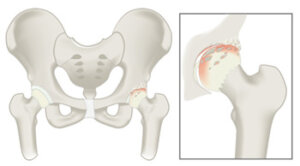Feeling a painful twinge in your hip? We have a helpful overview of common causes of hip pain, injuries and diseases, with recommended treatments.
Even the healthiest of us is occasionally beset by an ache or pain. Hip pain can be particularly unsettling, in part because our hip joint is engaged in moment-to-moment functions like sitting, standing, walking, climbing stairs and getting in and out of a car. When the joint is in pain, we notice.
Our hip is a ball-and-socket joint providing us with both movement and the stability we need to bear our body weight. The ball of the hip joint is located at the top of the femur (or thighbone). It fits into the cup-like pelvic socket called the acetabulum. A ring of fibrous cartilage, called the labrum, covers the outside rim of the socket, sealing the joint, holding the ball of the femur in the socket, providing the joint cartilage with nutrition, and stabilizing the joint. The labrum is held in place by strong ligaments that surround the hip.
Causes of hip pain range from injuries like sprains, dislocations and fractures to diseases including osteoarthritis, osteonecrosis (where bone tissue dies due to lack of blood supply) and genetic bone deformities (called impingements) of the hip socket.
The source of hip pain can give us clues about the nature of the problem. When the pain is located inside the hip or groin, it indicates a possible problem with the joint itself. Pain on the outside of the hip, upper thigh or buttock points to an issue with the muscles, ligaments, tendons or other soft tissues surrounding the joint. Some of the more common hip injuries and disorders include:
Sprain or strain
If you feel soreness, bruising, burning, swelling and stiffness, you may have stretched or torn a ligament. In most cases, rest, ice packs, a compression bandage and medications will resolve the injury.
Dislocation
When the bones of the joint are forced out of position by trauma, you need immediate medical attention. Treatment involves repositioning the hip, and then working with a medical team to give your joint time to heal fully without re-injury.
Fracture
A physical break in the bone may be caused by an injury, or by low bone density or osteoporosis. Fractures also require immediate medical attention to realign the bones with a cast or surgical procedure.
Osteoarthritis
The most common type of arthritis, osteoarthritis develops over time as wear and tear gradually deteriorate the cushioning cartilage within the joint. In the early stages, osteoarthritis is treated with pain relievers and light exercise. As the condition advances, surgery may be required.
Osteonecrosis
This is bone loss in the head of the femur resulting from an interrupted blood supply to the bone. It is caused by an injury, developmental disorders, and by the use of drugs, particularly cortisone or prednisone. Treatment is focused on preventing further bone loss through medications, therapy, and, in advanced cases, surgical procedures.
Hip impingements
Impingement is a genetic condition; a person is born with too much bone on the femur or on the pelvic cup that holds the femur. Frequently, this condition is asymptomatic, but injuries occur when the labrum is caught between the ill-fitting bones, causing the labrum to tear or fray. Treatment requires a surgical repair.
Although some hip pain will resolve with rest, we encourage you to consult a hip specialist if your hip pain is persistent. The sooner an injury is diagnosed, the easier it will usually be to restore your joint to maximum function.
When to seek treatment for your arthritis
Arthritis doesn’t have to spell the end of an active life. If you are experiencing worrisome symptoms or persistent pain, the renowned arthritis specialists at Summit Orthopedics can help. We work with you to confirm a diagnosis and develop an appropriate conservative treatment plan. If nonsurgical treatments fail to support your lifestyle goals, fellowship-trained orthopedic surgeons will consult with you and discuss appropriate surgical options. Summit is home to innovative joint replacement options. Our Vadnais Heights Surgery Center is one of only two surgery centers nationally to receive The Joint Commission’s Advanced Certification for Total Hip and Total Knee Replacement.
Start your journey to healthier joints. Find your arthritis expert, request an appointment online, or call us at (651) 968–5201 to schedule a consultation.
Summit has convenient locations across the Minneapolis-St. Paul metro area, serving Minnesota and western Wisconsin. We have state-of-the-art centers for comprehensive orthopedic care in Eagan, MN, Plymouth, MN, Vadnais Heights, MN, and Woodbury, MN, as well as additional community clinics throughout the metro and southern Minnesota.
More resources for you
- Ask Dr. Warner: Do I Have a Hip Labral Tear?
- Ask Dr. Wickum: What Questions Should I Ask My Hip Surgeon?
- Ask Dr. Wickum: How long does a hip replacement last?
